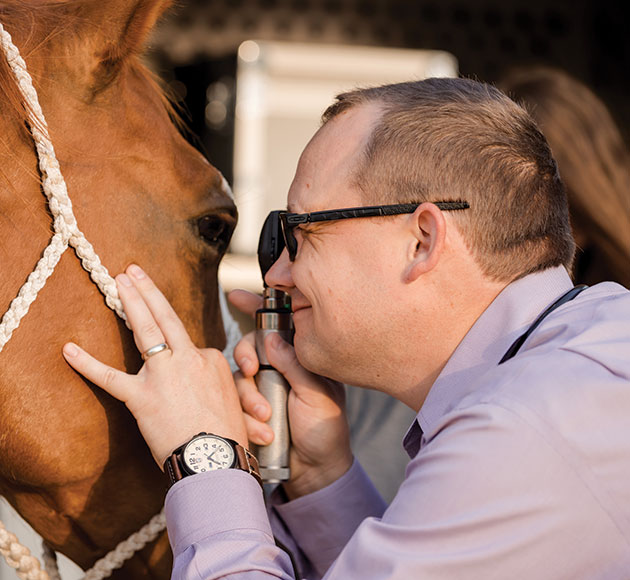While Early Treatment is Key to Preventing Serious Illness, This Tick-Borne Disorder Often Mimics Other More Common Diseases, Making Diagnosis Difficult
Over the past 20 years, a series of environmental and human factors have contributed to a population explosion of ticks throughout North America. These parasites feed on the blood of people and animals, while spreading to the hosts viruses, parasites and bacteria, including Borrelia burgdorferi, a pathogenic spirochete that causes Lyme disease. Named after Lyme, Connecticut — the New England town where it was first recognized in 1975 — Lyme disease has become the most common tick-borne disease in the U.S. with 30,000 human cases reported to the Centers for Disease each year. Moreover, two separate studies estimated that the true number is 10-times higher. Likewise, equine Lyme disease is becoming a bigger concern among veterinarians; the result of dramatic increases in identified cases. While not as common as other health issues affecting horses, Lyme disease has the potential to seriously impact equine health.


Lyme disease has become the most common tick-borne disease in the U.S. with 30,000 human cases reported to the Centers for Disease each year. Equine Lyme disease is becoming a bigger concern among veterinarians, the result of dramatic increases in identified cases.
Lyme disease has become the most common tick-borne disease in the U.S. with 30,000 human cases reported to the Centers for Disease each year. Equine Lyme disease is becoming a bigger concern among veterinarians, the result of dramatic increases in identified cases.
PHOTOS BY ELIZABETH HAY PHOTOGRAPHY
Current research suggests that to transfer bacteria, a tick must remain attached to a horse for approximately 18 to 24 hours. Quick removal of ticks is crucial to reducing risk of infection.
Causes
The U.S. is home to two families of ticks — Ixodidae (hard ticks) and Argasidae (soft ticks). These eightlegged parasites look like insects but are related to spiders. Researchers, led by the Yale School of Public Health, found that the Lyme disease bacterium has been circulating in North American forests for at least 60,000 years, including dozens of millennia before the last major glacial period. And the recent infectious surge is related to ecological changes of forest fragmentation and growth of the deer population in the last century, which created optimal conditions for the spike in tick numbers.
As a result, Lyme disease infected multiple species other than horses and humans including, dogs, cats, white-footed mice, birds and more. Several tick species can spread a litany of diseases, but the Lyme disease vector is limited to the tiny Ixodes scapularis in the East and Ixodes pacificus on the Pacific coast. These are more commonly known as blacklegged ticks, or deer ticks.
The appearance of the adult tick — dark, reddish brown in color — changes on whether or not it has recently taken a blood meal. It is not possible to tell by sight if a tick has Lyme disease. Ticks can’t jump and don’t drop from trees. They climb grasses and shrubs, waiting to make contact with a passing host in a behavior called “questing.” Adult female Ixodes are responsible for the highest percentage of infection. Current research suggests that to transfer bacteria, a tick must remain attached to a horse for approximately 18 to 24 hours. Quick removal of ticks is crucial to reducing risk of infection.
Blacklegged ticks continue to expand their range. Endemic areas include the Northeastern, mid-Atlantic and upper Midwestern U.S., as well as Southeastern Canada, with estimates that up to 30% of Ixodes tick populations are infected with B. burgdorferi. A 2003 study at Cornell University in Ithaca, New York, reported that 50% of horses in the Northeastern U.S. tested positive for exposure to the bacteria. The horses were healthy and not displaying clinical symptoms, suggesting that exposure is on the rise and higher than was expected. Peak high-risk periods are April to October, although climate change has pushed it into late fall and even winter months.
Symptoms

Horses with chronic Lyme disease can develop a Borrelia-associated uveitis, an inflammation within the eye with ocular discharge.
Horses with chronic Lyme disease can develop a Borrelia-associated uveitis, an inflammation within the eye with ocular discharge.
Equine Lyme disease has a huge variation in symptoms or potentially no symptoms at all. Not all infected horses even develop clinical signs. In fact, it’s common for a horse to show exposure to B. burgdorferi through blood antibody levels but not display any outward symptoms and otherwise be completely healthy. Essentially, a horse can be exposed, infected, develop antibodies and not show any signs of the disease.
Diagnosing it in horses can be very difficult. Lyme disease has been called “the great imitator,” as its symptoms overlap or can appear similar to several other illnesses. Lameness with a fever can be an important telltale as they are not often seen together in other disease states. Joint and muscle stiffness, weight loss, skin sensitivity or behavior changes are other common symptoms. Infected horses might show one sign or all of the following with varying severity and frequency.
Horses with chronic Lyme disease can develop a Borrelia-associated uveitis, an inflammation within the eye with ocular discharge. It is an unusual type of uveitis with the bacteria being carried in the vitreous fluid of the eyes and is associated with rapid progression, sometimes leading to blindness. Lyme uveitis may also precede the onset of nervous system symptoms, including neuroborreliosis, a rare but serious condition. This can present as behavioral changes and depression, loss of balance and gait abnormalities (ataxia), neck and back stiffness, fever, general sensitivity, respiratory distress, difficulty eating, muscle atrophy and encephalitis (brain swelling). This form of the disease can be fatal.
Common Symptoms of Equine Lyme Disease:
- Chronic weight loss or low appetite
- Low-grade fever
- Muscle tenderness or soreness, often sore back
- Lethargy
- Poor performance, low energy or reluctance to work
- Lameness (sporadic or shifting leg)
- Joint swelling or discomfort
- Laminitis
- Stiffness
- Arthritis
- Skin sensitivity (hyperesthesia) to being touched or brushed, typically with a rapid onset
- Behavioral changes: Irritable, nervous or aggressive behavior, coming on quickly
Diagnosis

To diagnose Lyme disease, a horse must show antibodies to the organism combined with clinical symptoms.
To diagnose Lyme disease, a horse must show antibodies to the organism combined with clinical symptoms.
The fact is: Lyme disease is difficult to diagnose. While early diagnosis is the key to preventing the most serious side effects, the disease unfortunately gives the appearance of a plethora of common disorders, including osteoarthritis, osteochondritis dissecans (OCD), muscle soreness (rhabdomyolysis or tying up, ER), equine protozoal myeloencephalitis (EPM) or simply overwork. Because of this, diagnosing Lyme disease is often a process-of-elimination effort. The tiny tick or its bite mark are rarely actually seen. Symptoms often do not surface for weeks or even months, and then are infamously vague and variable.
To diagnose, a horse must show antibodies to the organism combined with clinical symptoms. It requires the identification of the pathogenic organism — in blood serum or cerebrospinal fluid. Standard blood tests can detect antibodies for the bacteria. However, basic bloodwork doesn’t differentiate whether it’s a past or present issue, or simple exposure versus an active infection. It takes three to eight weeks for a horse to produce antibodies, and false negative test results are possible if blood is tested too soon after infection. Another complication is a horse exposed several years prior can still produce a positive antibody test. Cornell University’s Veterinary Diagnostic Center has recently developed the Lyme Multiplex assay that is able to identify antibodies from new versus old exposure or infection.
As horses that contract Lyme disease are not immune from future infections, it is important to stay vigilant with prevention protocols even after treatment.
“Lyme disease is a frustrating disease. Because it has symptoms common to many other diseases and can be difficult to diagnose, it can be both underdiagnosed and overdiagnosed. Subtle signs can fly under the radar in horses truly infected, but it is also inappropriately blamed for all sorts of clinical situations in unaffected horses.”
— Matt Durham, DVM, DACVSMR, Platinum Performance® Technical Services Veterinarian
Treatment
Once recognized, it is much better to treat Lyme disease early before it becomes a chronic issue. Early antibiotic treatment achieves positive outlooks in most cases. Tetracycline antimicrobials — oxytetracycline, doxycycline and minocycline — are the preferred treatment. Intravenous administration of oxytetracycline is more effective than oral methods. These antibiotics offer anti-inflammatory properties that may help ease symptoms. Some veterinarians will start with a short course of IV oxytetracycline and follow up with oral doxycycline, often for several weeks. Penicillin and cephalosporins, such as ceftiofur, are intramuscular antibiotics which are also effective against B. burgdorferi. Nonsteroidal anti- inflammatories are sometimes prescribed, including flunixin meglumine (Banamine) or phenylbyutazone (bute), that also support pain relief. Treatment generally lasts four to eight weeks. While some horses show improvement shortly after starting antibiotics, it’s crucial to continue the prescribed treatment because the bacteria are not gone. Damage caused by untreated Lyme disease can last a lifetime. Treatment success relates to improved clinical signs. Antibody titers will likely decrease with treatment as the infection clears, although antigens may remain detectable in the blood, and a horse can potentially relapse, even years later.
Tips for Limiting Your Horse’s Exposure to Ticks

Daily grooming is helpful for prevention as ticks need to feed on a horse for 18 to 24 hours to transmit the bacteria. Grooming allows you to see and feel bumps that might indicate a tick is attached. Brushing can remove ticks that are not fully attached.
Daily grooming is helpful for prevention as ticks need to feed on a horse for 18 to 24 hours to transmit the bacteria. Grooming allows you to see and feel bumps that might indicate a tick is attached. Brushing can remove ticks that are not fully attached.
- Use insect repellent sprays or wipes that contain permethrins, which are used to kill or repel ticks. Although short-acting, these insecticides can prevent ticks from attaching to the horse’s body. Apply liberally when adult ticks are active which can have a longer season than flies. Topical repellents are usually effective for a few hours, and should be re-applied regularly.
- Ticks inhabit tall and dense grass and wooded environments. Make pastures or turnout areas unwelcome for ticks (and mice). Keeping the grass mowed can help prevent ticks from crawling up tall grasses. Clear brush and wood piles and trim overhanging branches. Restrict grazing in wooded or brushy areas as much as possible. Do not encourage deer.
- Inspect horses daily for ticks, and always when coming in from turnout or after a trail ride. Daily grooming is helpful for prevention as ticks need to feed on a horse for 18 to 24 hours to transmit the bacteria. Ticks are small and difficult to see, but grooming allows you to see and feel bumps that might indicate a tick is attached. Brushing can remove ticks that are not fully attached. Check in dark, warm areas of the body: mane and tail hairs, around ears, between hind legs, under the belly and tail, and in the sheath in males or udder in mares.
- If a tick is found on the horse, it needs to be promptly and properly removed. Wear gloves if possible, and use tweezers (or a tick removal tool) to grasp it where it contacts the skin — where its mouthparts are embedded — and gently pull outward in a steady and firm motion. Don’t squeeze the tick’s body. Put the tick in rubbing alcohol or a sealed bag to destroy it.
Prevention
There is no approved vaccine against equine Lyme disease. Canine Lyme vaccines have been trialed off-label for equines with promising results, although they are short-lasting and require frequent boosters. Equine protocols have not been established. Tick control is currently the best defense.
Other Tick Troubles: Anaplasmosis and Piroplasmosis

Deer ticks are capable of transmitting Anaplasma phagocytophilum, which causes equine granulocytic anaplasmosis (formerly called equine granulocytic ehrlichiosis). This disease affects horses of all ages, but symptom severity can vary. Symptoms include high fever, depression and lethargy, leg edema, loss of appetite, reluctance to move, stumbling and ataxia. In the U.S., this illness is reported in the same locations as Lyme disease, but cases have also been reported in California where Western blacklegged ticks are carriers.
A blood test can confirm infection, and the same tetracycline antibiotics that treat Lyme disease are used against anaplasmosis. Horses that have had it do develop a natural immunity that protects them from reinfection for several years.
Equine piroplasmosis (EP) is another tick-borne disease affecting horses and other equids (donkeys, mules and zebras). Several hard ticks from the Ixodidae family are capable of carrying the disease caused primarily by two protozoan parasites: Theileria equi or Babesia caballi.
Blood tests can identify the parasites. As a blood-borne disease, it can also be transferred by transfusions and contaminated equipment. EP is a rare but devastating disease that most horse people are unaware of. Clinical signs are nonspecific but include fever, anemia, jaundice, anorexia, labored breathing, weakness, exercise intolerance and potential neurological signs. Mortality rates for horses can reach as high as 50%.
EP is a foreign animal disease; the U.S. is currently considered free of the parasites causing the malady. Confirmed cases must be reported to State and Federal animal health officials. Treatment options include supportive care and antiparasitic drugs, including imidocarb dipropionate (Imizol). Horses that are unable to permanently clear the infection must be kept under lifetime quarantine or be euthanized.

